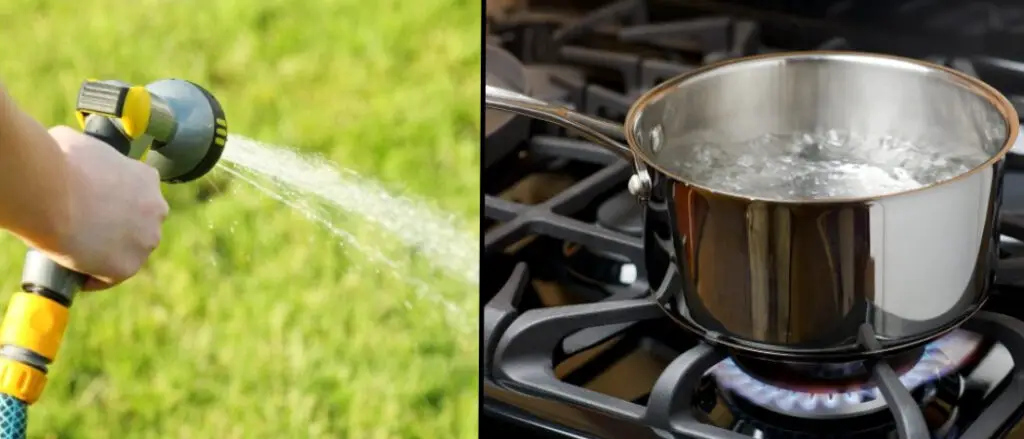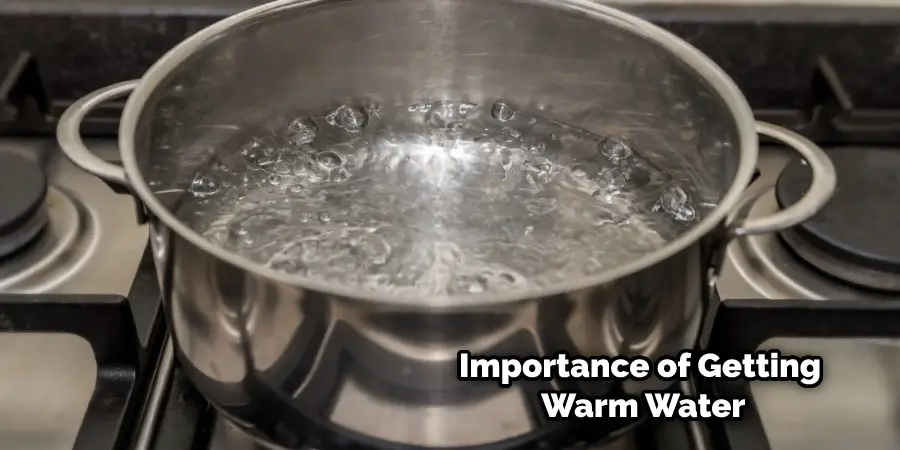If you’ve ever been camping out in the wilderness and wanted to take a hot shower or warm up with a cup of tea, then you know how difficult it can be to get that water warm. You may try boiling it over a fire, but this is both time-consuming and not always reliable; plus, starting a fire requires extra equipment. But don’t worry– there’s an easier way! This post will explore several methods for getting warm water without relying on metal cookware or campfires. We discuss all types of different ways, including solar heating, chemical reactions, insulating materials, and more, so that you can find the best method for your specific needs when trying to make warm water outdoors. So keep on reading this article to know more about how to get warm water outside.

Importance of Getting Warm Water Outside
Getting warm water outside can be important for a variety of reasons, including:
- Comfort: Warm water can help make outdoor activities more comfortable, especially during colder months or in cooler climates. This can be particularly important for outdoor bathing, showering, or other water-related activities.
- Health and hygiene: Warm water is often necessary for maintaining good health and hygiene. For example, warm water is recommended for washing hands, cleaning dishes, and bathing to help kill germs and bacteria that may be present.
- Convenience: Having access to warm water outside can be convenient for a variety of reasons, such as washing pets or cleaning outdoor equipment. This can save time and make it easier to accomplish tasks without having to go inside.
- Outdoor living: Many people enjoy spending time outside and may have outdoor living spaces such as patios, decks, or outdoor kitchens. Having access to warm water can make it easier to cook and clean outside, making outdoor living more enjoyable.
- Energy savings: Using warm water outside can help reduce energy costs and save resources. For example, using a solar water heater or a propane/natural gas water heater can be more energy-efficient than heating water indoors and transporting it outside.

Overall, getting warm water outside can help improve comfort, hygiene, and convenience while also saving energy and resources. It can be a valuable addition to any home or outdoor living space.
10 Methods on How to Get Warm Water Outside
Method 1: Solar Heating:
This is probably the most obvious way to get warm water outside, as it relies on using the heat from the sun. All you need is a black material (like rubber or plastic) that will absorb the solar energy and transfer it to your water. You can then use this method by placing containers of dark-colored liquids in direct sunlight. It’s important to keep the containers well insulated, as this will help retain some of the heat.
Method 2: Chemical Reactions:
Chemical reactions are one of the most efficient ways to generate warmth from other sources aside from fire or direct sunlight. For example, you can use a chemical reaction between salt and water to generate heat. All you need is a container filled with water and some salt, and the reaction will cause the water to become warmer than its original state.

Method 3: Insulating Materials:
Insulating materials are great for trapping in warmth from other sources, such as fire or sunlight. A simple example of this would be using a material like wool or cotton (or another insulating material) to wrap around your container of water. This will help to retain the warmth from whatever source you are using and keep it for longer periods of time.
Method 4: Heat Exchangers:
Heat exchangers are devices that transfer heat from one object to another. These can be used to transfer heat from a fire or stove to your container of water, allowing you to get warm water without boiling it over the fire.
Method 5: Electric Heaters:
Electric heaters are one of the most efficient ways to get warm water outside, as they do not require any additional fuel source and can be plugged into an outlet. Electric heaters are usually small, so they can easily be taken camping with you. They are also quite affordable and will provide you with warm water quickly.
Method 6: Fire Brick Heaters:
Fire brick heaters are great for providing warmth in all kinds of settings, especially for outdoor activities. These heaters use bricks that are placed in a fire and the heat from the fire is then transferred to your containers of water, providing you with warm or even hot water.
Method 7: Large Water Containers:
If you don’t want to take up too much space with a full-sized heater, then large water containers are a great option. All you need to do is fill up the container with cold water and place it near a fire or direct sunlight, and it will slowly become warm over time.
Method 8: Flotation Devices:
Flotation devices are great for providing warmth outdoors without the need for a fire or other heat sources. You can use these devices by filling up your container with water, then trapping it inside a flotation device that is submerged in a body of warm water (such as a hot spring). The warmth of the surrounding water will then transfer to your container, providing you with nice and warm water.
Method 9: Heat Packs:
Heat packs are small, disposable packets that contain some kind of chemical reaction. When the packet is opened and exposed to air, it will begin to generate heat. You can use these in your container of water by simply adding one or two packets and letting them do their thing. The warmth generated by the heat packs will transfer to your water, giving you a nice and warm temperature.
Method 10: Geothermal Sources:
If you’re lucky enough to have access to a geothermal source in your area, this can be an incredibly efficient way to get warm water outside. All you need to do is find a nearby geothermal source, such as a hot spring or volcano, and use it to fill up your water container. The warmth of the water will then transfer to your container and provide you with warm water.
These are just some of the ways you can get warm water outside without having to rely on traditional methods like boiling over a fire or leaving it out in direct sunlight. Try these methods out and see which one works best for you!
Warning Tips While Getting Warm Water Outside
1. Always Be Aware of Your Surroundings:
Pay attention to your surroundings and be aware of any potential risks when attempting to get warm water outdoors.
2. Stay Away from Open Flames:
Never use open flames or other sources of heat near your containers of water as this can be dangerous.

3. Use Caution Around Flammable Materials:
Be careful when setting up your heating source, as some materials may be flammable and can cause a fire.
4. Never Leave Water Unattended:
Always keep an eye on your water and make sure it is not boiling over or reaching a dangerous temperature.
5. Store Hot Water Properly:
If you have any hot water left over, make sure you store it properly in a sealed container. This will help keep the heat contained and prevent scalding accidents.
6. Don’t Use Unsafe Sources:
Never use unsafe sources of water, as these can contain bacteria and other contaminants that can be harmful to your health. Always make sure you are using clean, safe sources of water for any heating process.
7. Monitor the Temperature:
Always monitor the temperature of your water and make sure it is not getting too hot or too cold. This will ensure that you get a comfortable amount of warmth without any risk of scalding.
8. Always Follow Directions:
When using heating devices, make sure to follow all directions properly and never attempt to modify the device in any way.
These are just a few tips on how to get warm water outdoors safely and efficiently. Following these guidelines will help ensure that you have access to safe, comfortable warmth when needed.
Frequently Asked Questions
Q: Can I Connect a Garden Hose to A Hot Water Source Inside My House to Get Warm Water Outside?
A: Yes, you can. You can connect a garden hose to a hot water source inside your home and run it outside. However, you may need to use a longer hose or add an extension to reach the desired location.
Q: What Is a Portable Propane Water Heater?
A: A portable propane water heater is a compact and easy-to-use device that heats water on demand. It typically uses propane gas as fuel and can be used for outdoor showers, camping, and other outdoor activities.
Q: Can I Install an Outdoor Shower with A Heater Myself?
A: Yes, you can install an outdoor shower with a heater yourself if you have the necessary plumbing and electrical skills. However, hiring a professional plumber or electrician is recommended to ensure that the installation is safe and up to code.
Q: Is It Safe to Boil Water Outdoors?
A: Yes, it is generally safe to boil water outdoors as long as you do not leave the pot unattended and take proper safety precautions when working with an open flame. Make sure the area around your boiling pot is clear of any flammable materials before beginning.
Conclusion
Getting warm water outside can be a difficult task, but with the right preparation and knowledge, it is possible. By using solar energy to heat up your water in an insulated container or by utilizing propane-powered devices such as camp showers, you can get hot water while outdoors without having to worry about burning out electrical appliances.
Additionally, if you are camping near a river or lake, boiling your drinking and washing water over an open fire will also provide clean and safe warm water for use. With these tips in mind, there should no longer be any excuse for not being able to enjoy hot baths even when sleeping under the stars! Thanks for reading this article about how to get warm water outside.
